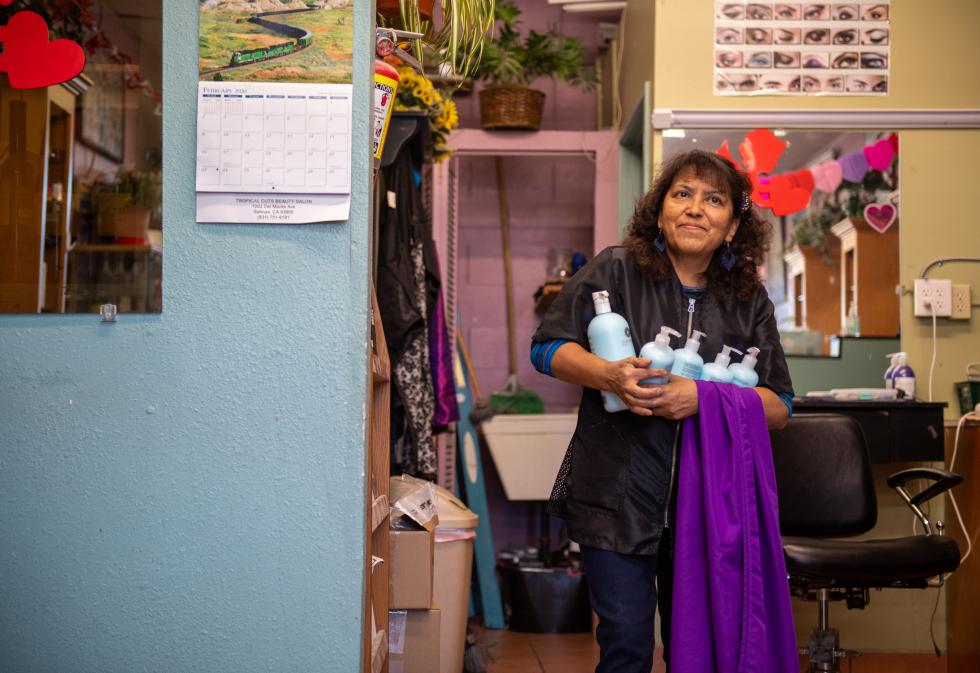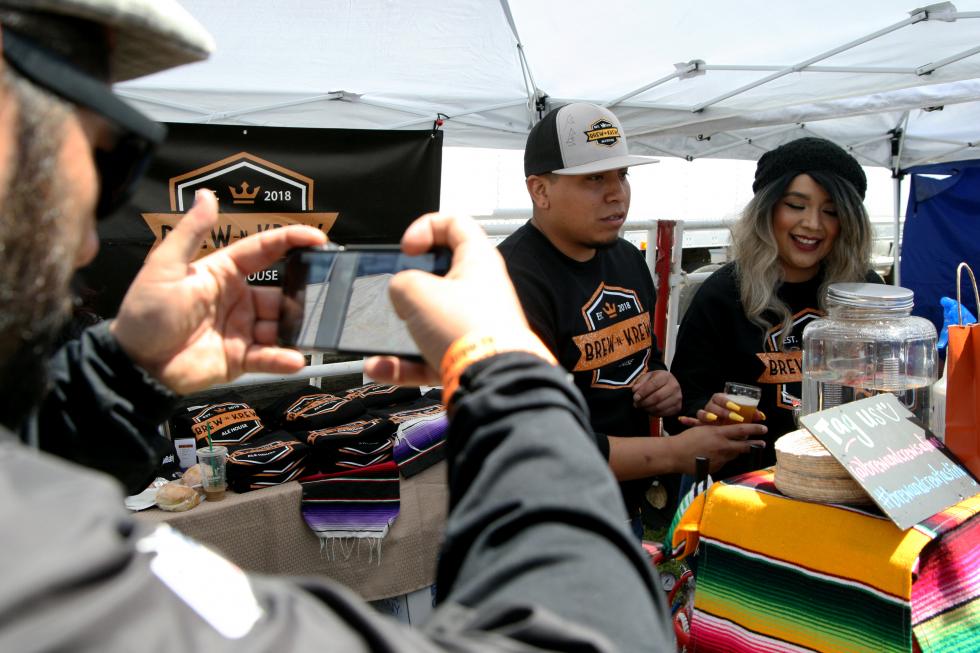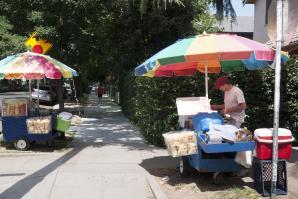On the weekends, Salinas food truck owner Orlando Osornio, 30, and his wife, Denise, sell mile-high tortas, filled with California fusion-inspired ingredients: hot Cheetos, bacon, mango-habañero sauce or pineapple. Some come for the birria torta or the chicken-bacon-alfredo torta.
A line of customers winds its way around the side of his tent as meat sizzles on the grills. On the other side of the mesh, Osornio and his crew pack and stack toasted buns as fast as they can.
Two years ago, when Osornio, who is Mexican-American, was contemplating launching Tortas al 100, he knew one thing: He didn’t want to apply for a loan. Osornio had racked up “about $30,000” in credit-card debt as a teenager and when life smacked him in the face in his early 20s, he got serious about paying it down and fixing his credit score.
That experience, he said, was what prompted him to forgo applying for a small business loan. Instead, Osornio estimated he and his wife spent at least $50,000 of their salaries on the burgeoning business, including food, four grills, a tent and more during its first year of operation.
Latino small business owners like Osornio are the fastest-growing group of entrepreneurs in the U.S., even as they battle systemic racism that has resulted in lower incomes and loan rates. Over the past 10 years, the number of Latino business owners grew 34%, compared to 1% for all business owners in the United States, according to a recent study from Stanford University. And more Latinos than ever are applying for small business loans to launch or grow their operations.
Becoming an economic force
FaustaIbarra, 59, owner of Tropical Cuts Beauty Salon in Salinas,
carries shampoo and conditioner bottles to the front of the
store. (Photo by Kate Cimini, The Salinas Californian)

The growing success of Latino small business owners comes as Latinos are increasingly becoming an economic force in the U.S. The same Stanford study found Latino-owned businesses contributed about $500 billion to the economy in annual sales.
A 2019 report to Congress based on data from 2017 found almost 60 million Latinos in the United States already account for $2.3 trillion in economic activity in total, which on its own would rank as the eighth largest economy in the world. And Latinos are projected to make up 30% of the U.S. population by 2020, meaning the group’s contributions are only likely to grow.
Latino-owned businesses employ more than 3 million people, the 2019 State of Latino Entrepreneurship report by the Stanford Latino Entrepreneurship Initiative (SLEI), a Stanford University research initiative centered around Latinos in business, found. All told, Latino-owned businesses account for about 4% of U.S. business revenues and 5.5% of U.S. employment.
However, Latino-owned companies remain smaller than white-owned firms, averaging only $1.2 million in revenue compared with $2.3 million brought in by a white-owned company.
That is a problem, said Jerry Porras, a professor of organizational behavior and change emeritus at Stanford Business School, cofounder of the Latino Business Action Network, a nonprofit out of Stanford University focused on empowering Latino business owners, and co-director of SLEI.
“I think that there’s really a positive story when you look at Latino businesses across the country,” said Porras. “The number is smaller as a base but its growing very rapidly. Latinos are oriented towards starting businesses and are doing it at a significant rate.”
If Latino-owned employer firms were given the same chances, Porras said, they would generate an additional $4 billion in revenue and 1 million jobs.
Younger than other entrepreneurs
Across the U.S., Latinos are represented in all the major industry sectors, owning businesses in manufacturing, education, health services, finance, construction and more.
Latino business owners tend to be younger than non-Latino business owners. Roughly 33 percent of Latino entrepreneurs are younger than 45, compared to just 22% of non-Latino entrepreneurs.
For every 100,000 Latino adults in the United States, on average 510 became entrepreneurs each month in 2018.
However, research by the Institute on Assets and Social Policy, an institute that studies economic opportunities for people of color, evidences that historic disenfranchisement of people of color has led to those very people having less generational wealth than white people.
Furthermore, policies that favor the affluent have continued to widen the gap, particularly between white families and black or Latino families.
While the income gap between blacks and whites closed somewhat between 1970 to 2016, Hispanics fell even further behind at all income levels, the Pew Research Center think tank found in 2018. Even top-earning Hispanics earned only 65% as much as whites in 2016, down from 74% in 1970.
And Hispanic people on average continue to make lower salaries than white people, research out of Stanford showed.
In the end, this combination means Latinos typically have lower credit scores, which, in turn, can mean higher interest rates or being turned down for loans.
According to a report submitted to the U.S. House Financial Services Committee in 2019 by UnidosUS, a nonpartisan think tank focused on the Hispanic community, banks originally had loan officers who determined the “trustworthiness” of a loan applicant. As such, people of color were often discriminated against.
In the following decades, banks lost their loan officers to the war effort, and soon invented credit scores as a stand-in. However, these, too, had their issues as they were built on longstanding disparities and have resulted in communities of color, young adults, people with low income and immigrants having disproportionately low credit scores.
According to the 2017 Small Business Credit Study by the Federal Reserve Banks, of applicants denied credit, 45% of Latino applicants were denied for insufficient credit history and 37% were denied for having too low a credit score. (Applicants could choose more than one response.) In comparison, white applicants were turned away at rates of 33% and 26% for the same reasons.
“I think the Latino story in some ways follows the story of why black families have less wealth than white people today,” said Urban Institute research fellow Steven Brown. “There is a lack of the same kind of resources that help build wealth.
Brown cited restricted access to homeownership under policies such as “redlining” as a primary way Latinos were kept from building generational wealth. For decades, black and Latino neighborhoods were unfairly deemed too risky for loans and mortgages through redlining. That left people in those neighborhoods reliant on speculators or private sales.
“When Latinos have been able to buy homes, they have historically been relegated to neighborhoods where the homes didn’t have as much value so they’re unable to build as much wealth and pass it on,” said Brown.
In more recent years, as Latinos have become more prominent in U.S. culture, their economic standing is also rising.
A 2019 study of 61,000 small-business loan applications submitted to Biz2Credit’s online marketplace found that the number of credit applications from Latino-owned businesses rose 23 percent from 2018 to 2019.
Outpacing US economy
(Brew-N-Krew co-owners Marlene and Steven Garcia serve customers
at Steinbeck’s Home Brew Fest. Photo by Kate Cimini, The Salinas
Californian)

And over the last year, Latino-owned businesses reported an average revenue growth of 14%, outpacing the growth of the U.S. economy, the Stanford report showed.
While revenues climbed, though, the average credit scores of Latino business owners dipped to 588 from 594 last year, according to Biz2Credit.
According to Biz2Credit’s CEO, Rohit Arora, that could indicate business owners are using personal credit cards to fund their business growth if their companies did not qualify for loans. Furthermore, cost management can be difficult for young businesses, which may factor into the dip in scores.
“When credit scores are less than 600, it is hard to get traditional bank loans,” Arora said in the report his firm released.
Porras said the lack of credit can force Latino business owners to make riskier financial decisions, such as relying on personal credit cards to grow their business, or taking out a loan on their accounts receivable.
“By and large, I think Latinos are very unsuccessful in securing loans from the more professional sources,” said Porras. “It’s the smaller ones that are hurting the most,” added Porras, referencing business size.
In other cases, Latino borrowers may be less trusting of financial institutions as a whole, based either on past experiences or a general understanding of systemic racism by lending institutions.
“Latinos have to pay more for interest,” said Fausta Ibarra, 59, who owns her own hair salon, Tropical Cuts, in Salinas, California. “We have to pay more for everything.”
Ibarra, who calls herself a “cien por ciento,” or 100%, Mexican woman, herself had poor credit, after issues with a house she and her sisters bought together in the early 1990s. When she applied for a loan in 1993 to open her hair salon, a brightly lit salon tucked into a small strip mall in Salinas, Washington Mutual Bank denied the loan. (The bank collapsed in 2008 during the financial crisis.)
She ended up borrowing nearly $30,000 from friends, family, and coworkers, slowly paying them back one by one.
Later, when Ibarra tried to purchase a home in 1996, her low credit still held her back. There was, however, another way, the realtor told her. Ibarra ended up paying more than the house was on the market for, and she had to borrow from friends and family so she could put down a deposit of $10,000, twice what she was prepared to pay out of pocket.
Ibarra felt taken advantage of.
“Los Latinos tienen que ganarse el pan cada día,” said Ibarra in her native Spanish. “Yo sí pienso que los Latinos pueden contribuir más si nos dan la oportunidad para sacar adelante a nuestros hijos. Yo pienso que todos tenemos las ganas de progresar pero no se nos dan las facilidades que se les da a una persona ciudadana de aquí.”
That translates in English to: “Latinos have to start all over again, every day,” said Ibarra. “I do think that Latinos can contribute more to this country if they give us the same opportunity to better ourselves and our children. I think we all want to progress, but they don’t give us the same tools they give someone who was born here.”
Today, black people and Latinos continue to be routinely denied conventional mortgage loans at rates far higher than their white counterparts, according to Home Mortgage Disclosure Act records analyzed by Reveal for The Center for Investigative Reporting in 2018.
The analysis showed black applicants were turned away at significantly higher rates than whites in 48 cities, and Latinos in 25, even when controlling for loan size, neighborhood and income.
In other instances, black or Latino applicants were steered toward higher-cost, riskier loans.
Bank of America, for example, agreed to a $335 million payout to the Justice Department on behalf of its mortgage lender, Countrywide. Prior to Bank of America’s purchase of the lending institution, Countrywide purposely charged more than 200,000 black and Latino borrowers more for their mortgage loans than white borrowers with similar qualifications between 2004 and 2008.
The lender advised those borrowers of color to take out risky sub-prime loans, even when they qualified for prime loans, or simply charged them higher rates.
Other lending institutions, such as Wells Fargo, have had similar claims levied against them.
Latinos turn to friends, family for seed money
According to the 2019 Stanford report, Latinos get loans from local banks at a much higher rate than they do from national banks.
However, local banks are disappearing across the United States and in California, thanks to what some say are more onerous federal regulations, potentially leaving Latinos out in the cold. According to data provided by the Federal Deposit Insurance Corporation (FDIC), as of Dec. 31, 2001, 8,080 FDIC-insured community banks existed in the country. By Dec. 31, 2018, 5,406 remained.
“The local banks are tied to the community more tightly,” said Porras. “If the community has more Latino businesses, the relationships are built up and they grow. National banks lag behind there because local banks work harder to network with the businesses in their communities.
When local banks are not available, instead of applying to larger loan institutions, many Latinos turn to friends, family and crowdfunding for seed money.
In Salinas, a small city surrounded by rich agricultural land, U.S. Census Bureau data shows 78.7% of the some-156,000 residents are Hispanic or Latino. While the city’s agricultural industry thrives financially, thanks to the tens of thousands of Latino farmworkers that flow in and out of Salinas every year, the average farmworker takes home just $17,500 a year, according to the U.S. Department of Labor. More than 17% of its residents live in poverty.
Still, Latino entrepreneurship is evident in Salinas. Latino-owned restaurants, barbershops, grocery stores, showrooms and more have risen out of the landscape all over town, tucked into plazas and surrounding big box stores. Nearly 30% of all businesses in Monterey County, where Salinas rests, are owned by Hispanic or Latino people, per data provided by the Monterey County Workforce Development Board from the 2012 American Community Survey.
Marlene Garcia, 29, is the proprietor of a homebrew operation turned commercial brewery that will open in Salinas in the spring. She borrowed $210,000 from her mother to start up her operation.
Salinas’s downtown is just three blocks long, but Garcia’s brewery, Brew & Krew, will open on the 100 block of Main Street, near four other Latino-owned businesses that have opened (or re-opened under new ownership) in the last two years. The growth is notable on a side of town that is inhabited primarily by white residents.
“I am honestly so thankful for my parents, both of them,” said Garcia, reminiscing about her parents’ insistence that she help with the family businesses.
Her parents, Graciela and Gildardo, worked in fields after immigrating to the U.S. from Guanajuato, Mexico. Every month or so, they would go to Los Angeles, five hours away, to stock up on Mexican candy, piñatas and cassette tapes, Garcia said. Then, they would turn around and sell them at the Santa Cruz weekend flea market in central California, dragging their children with them.
It was there that Garcia learned the dedication it took to run a business, even as she told her parents she never wanted to own her own operation.
“Growing up, my entire life, we would go to the flea market,” said Garcia. “We’d wake up super early, drive to Santa Cruz, and work. I remember telling my parents, ‘I don’t want this, I don’t want to go into business.’
“Now that I’m older, I appreciate everything they did. I see why they did that.”
The Garcias opened another stand in another flea market, then a taquería. Finally, they sold all their businesses and took out their first loan of $80,000 to open a liquor store in Gilroy, a small bedroom community 30 minutes south of San Jose. They named the store La Flor de Jalisco.
When Garcia wanted to open her own brewery, her mother became her silent business partner.
“Because of them, because of the way they saved, because they saved, a lot of the money that has been invested came from my mom,” said Garcia.
Garcia is in the process of applying for her first loan — a Small Business Administration loan for $480,000 to open her business. She credits her mother’s help in allowing her to so far not rack up debt and interest rates.
Although the space is still unfinished, Garcia has big plans for her small brewery. She wants large, stainless steel canisters in the back, behind a large pane of glass so brew enthusiasts can watch the brewers at work as they sip on suds.
She hopes to connect with other business owners in the area to cross-promote, whether it be with the cinema next door or the sandwich shop across the street.
“Hispanic parents are never excited to hand out money,” Garcia said, laughing. “But she believed in it, she saw that people really do like beer. If she wouldn’t seen that reaction, it would have been harder to convince her.”
‘Puro cash’
Osornio, owner of Tortas Al 100, closes the back of his cargo
trailer. (Photo by Kate Cimini, The Salinas Californian)

Osornio’s family has a saying whenever they have to pay for something. “Puro cash,” they repeat, laughing, or pure cash in English.
The joke is based on Osornio’s father. Years ago, when he was purchasing a car for his wife, the salesman asked him if he wanted to finance.
“No,” said Osornio the elder. “Puro cash.”
Despite the financial savvy his father displayed, Orsonio said his parents rarely talked money management with him. All he recalls was being told credit cards were for emergencies only, a lesson that, like many teenagers, he immediately disregarded as soon as he got one of his own.
The experience of wiggling out from under a pile of debt taught Osornio that he wanted applying for a loan to be “a last resort.”
Years later, Osornio has managed to build such a successful business with his unique torta recipes that he routinely fields offers from locals to invest in or outright purchase his business — and his recipes — from him.
And that, advocates have said, is the hidden silver lining for Latino entrepreneurs: even more untapped potential.
According to a 2017 New American Economy report on the power of Hispanics in the U.S., Hispanic entrepreneurs own a large chunk of transportation and warehouse businesses, laying claim to more than 20% of the industry in 2012. They also owned about 12% of the country’s construction firms.
Advocates say that, given a chance, Latinos could grow their portion of the economy even further. However, the “opportunity gap” between Latinos or Hispanics and their white, business-owning counterparts is wide.
“Wealth is the missing ingredient in the Latino community,” said Porras. “If we could add more wealth, people would consume more and grow the economy. How do we get more wealth? Grow businesses.”
“It’s a synergystic process,” said Porras. “In the long term, it will benefit the whole country.”
All Latinos need, Porras said, is a chance.
–
Kate Cimini is a multimedia journalist for The Californian. This article is part of The California Divide, a collaboration among newsrooms examining income inequity and economic survival in California.
Recommended For You

Sacramento Looks to Expand Mobile Food Codes to Support Sidewalk Vendors
Sacramento’s effort to expand mobile food codes is part of a statewide push to legitimize California’s long tradition of sidewalk vending.

A Taste of Oaxaca
Mezcalito Oaxacan Cuisine shares regional Mexican culture with Sacramento diners
At Mezcalito Oaxacan Cuisine in Rocklin, the mole takes two days and nearly two dozen ingredients to complete. The recipe reads like a catalog of the Mexican state of Oaxaca’s agricultural bounty: plantains, green apples and raisins; warm spices and half a dozen kinds of chiles; a liberal dose of sparsely-sweetened chocolate.

Taste Makers
Yolanda Vega is the driving force behind the family’s expanding food brand
At 11 years old, Yolanda Vega started selling buñuelos and other local foods at street festivals around Michoacán. When she relocated to Sacramento in 1996, she did the same thing, driving around town and growing her clientele.

Neighborhood Favorite
La Placita has remained a constant during 30 years of growth in Orangevale
La Placita, a local favorite in Orangeville, has stood the test of time.



